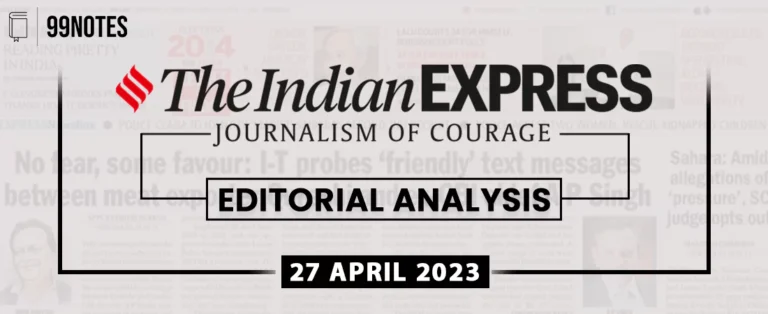20 Jan 2024 : Indian Express Editorial Analysis
Indian Express
20- January-2024
1. A green blueprint
| Topic: GS3 – Environment – Environmental pollution and degradation This topic is not much relevant in the context of Prelims but more for Mains in the context of environmental science, climate change, and air quality management in India. |
| Context: |
|
National Clean Air Action Plan (NCAP) and Mixed Results:
- India introduced the National Clean Air Action Plan (NCAP) in 2019 in response to the worsening air pollution situation.
- The plan’s report card highlights the necessity of bringing air pollution down to permissible levels even though the results are not all that positive.
- It is highlighted how air pollution and climate change are linked, as they both result from the burning of fossil fuels and industrial operations.
Climate Change, Extreme Weather, and Air Quality Emergencies:
- Extreme weather events that worsen air quality emergencies highlight the connection between climate change and air pollution.
- Climate change is making heat and cold waves more intense, which puts public health at risk and calls for immediate mitigation.
- Given the risk of suffering, illnesses, and death, it is imperative that these issues are addressed immediately.
Air Quality Management in India: A Three-Tiered Approach
- A comprehensive plan that addresses the levels of rural, urban, and industrial agglomerations is put forth for managing air quality in India.
- While acknowledging the current emphasis on analysis at the urban level, difficulties in implementing policies at the state and district levels are emphasised.
- This three-tiered method takes into account the various microenvironments and meteorological circumstances that exist throughout the nation.
Critical Factors: Air-Sheds, Baseline Levels, and Dynamic Factors
- The basic elements influencing air quality in India are discussed in detail, including air-sheds, baseline pollution levels, and dynamic factors like local emissions and weather.
- It highlights the need to prioritise the development of an air quality early warning system before creating two crucial input parameters: an emissions inventory and air-shed mapping.
Challenges in Pollution Prediction in India
- The complexity of developing a pollution prediction system is increased by the geographical diversity of Indian cities, which span different climatic zones with unique air-sheds and emission sources.
- The idea of baseline levels is presented; these represent normally occurring levels of ambient pollution and serve as a foundation for adjusting to and building immunity against pollution.
Emission Inventories and Air Quality Forecasting Challenges
- One significant drawback is the inadequate systemic inventory of emissions in India, which is made worse by a lack of reliable data and monitoring networks.
- To close this gap, new technologies including artificial intelligence based on drones, satellite-driven information, and ground-based data are suggested.
- Standardised reporting procedures and the investigation of CubeSats as a data collection tool are highlighted.
Proposed Indigenous Science-Based Framework
- The last element promotes an indigenous, scientifically grounded framework for air quality resources.
- The proposed consortium seeks to convert data into useful knowledge by bringing together topic experts, health scientists, policy professionals, communicators, and outreach groups.
- It is suggested that emissions data be centralised in accordance with international standards, that Indian satellite data be used extensively, and that new technology such as drones and CubeSats be utilised.
Conclusion:
- In order to regulate air quality in India, the plan promotes a multifaceted strategy that combines advocacy, policy, and science.
- The necessity of swift action at all levels to protect public health and lessen the effects of climate change is emphasised by the urgency of the situation, as demonstrated by COP 28 and the current air quality issues.
| PYQ: What are the key features of the National Clean Air Programme (NCAP) initiated by the Government of India? (UPSC CSE (M) GS-3 2020)(250 words/15 m) |
| Practice Question: Discuss the challenges and proposed solutions in the context of air quality management in India, with a focus on the integration of science, policy, and technology. (150 words/10 m) |
2. THE WHEAT TEST
| Topic: GS3 – Agriculture – Issues of buffer stocks and food security This topic is not much relevant in the context of Prelims but more for Mains in the context of Food security, current state of wheat stocks, agricultural policies, and their impact on the economy. |
| Context: |
|
Post-Election Supply Challenge:
- Although the current state of affairs is under control, a possible problem could emerge following the April–May national elections.
- Should the wheat crop, which is scheduled for harvest by the end of March, not yield satisfactory results, the new government may have difficulties with supplies.
- Since taking office, the Narendra Modi-led administration has been vigilant in controlling the supply of edible oils and pulses, permitting imports with little to no tariffs through March 31, 2025.
- But in the case of wheat, rice, and sugar, this proactive strategy has not been as apparent, maybe because growers in these industries have significant political organisations.
Policy Inertia and the Need for Import Considerations:
- The Modi government has put measures in place to prevent sugar mills from diverting cane juice and intermediate-stage molasses for the creation of ethanol, as well as to restrict exports.
- It hasn’t, however, started to allow imports. Imports might soon become necessary due to the finely balanced supply scenario, which includes uncertainties regarding real production and a six-year low in stocks at the start of the new sugar season in 2023–2024.
- It is now evident that there is a lack of predictability and consistency in agricultural policy, especially with regard to wheat, rice, and sugar.
Importance of a Strategic Vision for Agriculture:
- The article makes the case for the ideal situation, in which export and stocking controls are not used and the import window is left open for all agricultural commodities.
- It highlights that India’s agriculture needs a long-term strategy that addresses inflation episodes rather than just band-aid fixes.
- In contrast to industry and services, the farm sector in India has suffered from unstable policies, which has affected investments in processing, storage, marketing, and research.
- The article emphasises the need for the upcoming government to prioritise long-term policies that benefit both producers and consumers.
Conclusion:
- The analysis highlights the fragile situation of the wheat stocks at the moment and the difficulties that may arise after the election.
- It draws attention to the necessity of a more thorough and methodical approach to agricultural policy, stressing the value of consistency, predictability, and a long-term outlook for the good of all industry participants.
| PYQ: What are the major factors responsible for making rice-wheat system a success? In spite of this success how has this system become bane in India? (UPSC CSE (M) GS-3 2020) (250 words/15 m) |
| Practice Question: Evaluate the current state of wheat stocks in government warehouses, analyzing its implications on food security and the economy. (150 words/10 m) |
For Enquiry

13 Feb 2024 : Daily Current Affairs Quiz

13 Feb 2024 : Daily Answer Writing

13 Feb 2024 : Daily Current Affairs

13 February 2024 : The Hindu Editorial Notes PD

13 Feb 2024 : Indian Express Editorial Analysis

13 February 2024 : PIB Summary for UPSC

12 Feb 2024 : Daily Current Affairs Quiz

12 Feb 2024 : Daily Answer Writing

12 Feb 2024 : Daily Current Affairs

12 Feb 2024 : Indian Express Editorial Analysis
Daily Quiz 13 Feb 2024 : Daily Current Affairs Quiz 13 Feb 2024 : Daily Quiz…
mains answer writing 13 Feb 2024 : Daily Answer Writing Mains Answer Writing
13-February-2024
Q1) With the help of a map, show major ocean currents of the world….
Daily Current Affairs 13 Feb 2024 : Daily Current Affairs Daily Current Affairs
13-February-2024- Top News of the Day
1. Indian Navy Personnel Released from Custody…
Feb 2024 The Hindu 13 February 2024 : The Hindu Editorial Notes PD The Hindu Editorial
13-February-2024
1. A global alliance to bridge the gender equity gap
Topic:…
Indian Express 13 Feb 2024 : Indian Express Editorial Analysis Indian Express Editorial Analysis
13-February-2024
1. A science for us
Topic: GS2 – Governance…
feb 2024 PIB 13 February 2024 : PIB Summary for UPSC PIB Summary for UPSC
13-February -2024
1. Union Minister G Kishan Reddy inaugurate regional centre…
Daily Quiz 12 Feb 2024 : Daily Current Affairs Quiz 12 Feb 2024 : Daily Quiz…
mains answer writing 12 Feb 2024 : Daily Answer Writing Mains Answer Writing
12-February-2024
Q1) “Water scarcity threatens economic and social gains…
Daily Current Affairs 12 Feb 2024 : Daily Current Affairs Daily Current Affairs
12-February-2024- Top News of the Day
1. Great Indian Bustards give Nandyal a…
Indian Express 12 Feb 2024 : Indian Express Editorial Analysis Indian Express Editorial Analysis
12-February-2024
1. CLASSROOM VS COACHING
Topic: GS2 – Social…


